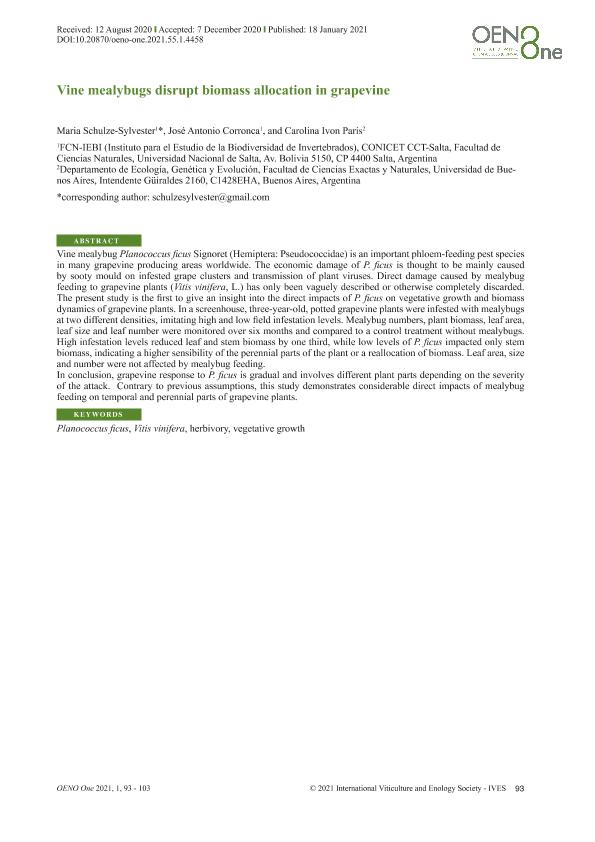Mostrar el registro sencillo del ítem
dc.contributor.author
Schulze sylvester, Maria

dc.contributor.author
Corronca, Jose Antonio

dc.contributor.author
Paris, Carolina Ivon

dc.date.available
2021-06-11T20:07:07Z
dc.date.issued
2021-01-18
dc.identifier.citation
Schulze sylvester, Maria; Corronca, Jose Antonio; Paris, Carolina Ivon; Vine mealybugs disrupt biomass allocation in grapevine; Vigne et Vin Publications Internationales; Oeno One; 55; 1; 18-1-2021; 93-103
dc.identifier.issn
2494-1271
dc.identifier.uri
http://hdl.handle.net/11336/133737
dc.description.abstract
Vine mealybug Planococcus ficus Signoret (Hemiptera: Pseudococcidae) is an important phloem-feeding pest species in many grapevine producing areas worldwide. The economic damage of P. ficus is thought to be mainly caused by sooty mould on infested grape clusters and transmission of plant viruses. Direct damage caused by mealybug feeding to grapevine plants (Vitis vinifera, L.) has only been vaguely described or otherwise completely discarded. The present study is the first to give an insight into the direct impacts of P. ficus on vegetative growth and biomass dynamics of grapevine plants. In a screenhouse, three-year-old, potted grapevine plants were infested with mealybugs at two different densities, imitating high and low field infestation levels. Mealybug numbers, plant biomass, leaf area, leaf size and leaf number were monitored over six months and compared to a control treatment without mealybugs. High infestation levels reduced leaf and stem biomass by one third, while low levels of P. ficus impacted only stem biomass, indicating a higher sensibility of the perennial parts of the plant or a reallocation of biomass. Leaf area, size and number were not affected by mealybug feeding. In conclusion, grapevine response to P. ficus is gradual and involves different plant parts depending on the severity of the attack. Contrary to previous assumptions, this study demonstrates considerable direct impacts of mealybug feeding on temporal and perennial parts of grapevine plants.
dc.format
application/pdf
dc.language.iso
eng
dc.publisher
Vigne et Vin Publications Internationales
dc.rights
info:eu-repo/semantics/openAccess
dc.rights.uri
https://creativecommons.org/licenses/by/2.5/ar/
dc.subject
HERBIVORY
dc.subject
PLANOCOCCUS FICUS
dc.subject
VEGETATIVE GROWTH
dc.subject
VITIS VINIFERA
dc.subject.classification
Ecología

dc.subject.classification
Ciencias Biológicas

dc.subject.classification
CIENCIAS NATURALES Y EXACTAS

dc.title
Vine mealybugs disrupt biomass allocation in grapevine
dc.type
info:eu-repo/semantics/article
dc.type
info:ar-repo/semantics/artículo
dc.type
info:eu-repo/semantics/publishedVersion
dc.date.updated
2021-06-07T16:37:59Z
dc.journal.volume
55
dc.journal.number
1
dc.journal.pagination
93-103
dc.journal.pais
Francia

dc.description.fil
Fil: Schulze sylvester, Maria. Universidad Nacional de Salta. Facultad de Ciencias Naturales. Instituto para el Estudio de la Biodiversidad de Invertebrados; Argentina. Consejo Nacional de Investigaciones Científicas y Técnicas. Centro Científico Tecnológico Conicet - Salta; Argentina
dc.description.fil
Fil: Corronca, Jose Antonio. Universidad Nacional de Salta. Facultad de Ciencias Naturales. Instituto para el Estudio de la Biodiversidad de Invertebrados; Argentina. Consejo Nacional de Investigaciones Científicas y Técnicas. Centro Científico Tecnológico Conicet - Salta; Argentina
dc.description.fil
Fil: Paris, Carolina Ivon. Universidad de Buenos Aires. Facultad de Ciencias Exactas y Naturales. Departamento de Ecología, Genética y Evolución; Argentina
dc.journal.title
Oeno One
dc.relation.alternativeid
info:eu-repo/semantics/altIdentifier/doi/http://dx.doi.org/10.20870/oeno-one.2021.55.1.4458
dc.relation.alternativeid
info:eu-repo/semantics/altIdentifier/url/https://oeno-one.eu/article/view/4458
Archivos asociados
